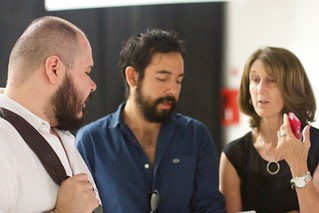There is a lot of interest in "Working out loud" and "narrating your work" at the moment. Here are 4 things you need to watch out for, to ensure this approach adds value to the organisation.
"Working out loud" (WOL) is, at first sight, a simple and attractive idea. Social Media and group-ware enable us to narrate what we are doing so that others can be aware (and so avoid duplication and offer insights), and to put our work products in common areas so that others can re-use them and build on them.
Indeed, tools such as Yammer encourage WOL, by prompting you with the question "What are you doing today?"
However there are a number of ways in which WOL, taken superficially, can go badly wrong, as shown by a case study at the end of this post.
Here are 4 pitfalls you need to address.
1. WOL must address demand as well as supply - Pull as well as Push.
Although WOL greatly increases knowledge sharing, the goal of Knowledge Management is not Knowledge Sharing but Knowledge Use. KM is ultimately about giving people access to better knowledge that will solve their problems, and setting a culture whereby they want to find and use that knowledge.
Knowledge re-use requires knowledge demand, and not just supply. People need to be actively seeking and asking, as well as actively telling and sharing. Any unbalanced market, where supply exceeds demand, leads to a crash in the value of the commodity (in this case, knowledge). Conversely where demand exceeds supply, the value of the commodity rises. Demand stimulates supply; supply does not always stimulate demand.
WOL can fail when it becomes only a mechanism for Telling - telling people what you are doing, telling people what you have done - a supply mechanism only.
If WOL is going to work, it needs to refocused as Asking Out Loud, or Questioning Out Loud. A sharing culture needs to be replaced by (or augmented by) an
Asking Culture. In-house Yammer should be asking
"What do you need help with today?". This way WOL becomes a demand-side mechanism.
Remember Shell's maxim of "Ask, Learn, Share" and remember that they prioritise them in that order.
Don't replace "Ask, Learn, Share" with "Tell, Tell, Tell"
There is often an assumption that telling what you are doing, and sharing work in progress, tacitly invites commentary, and is a proxy for seeking and asking. If you are doing something wrong, the assumption is that someone will correct you without you having to ask. The reality is determined by culture, and in many cultures around the world people hesitate to correct someone unasked, or to offer unsought feedback. If you want commentary then Ask, don't just Tell.
2. WOL creates "just-in-case" knowledge, not "just in time".
WOL, applied incorrectly, becomes a set of answers looking for a question. You narrate your work "Just In Case" someone is interested. You store your work products "Just In Case" they are of use to someone.
However we know that KM is most effective when it operates through "
Just In Time" rather than "Just In Case". People don't know what they need to know, until they need to know it (this is one of
the demand-side principles of Knowledge Management), and when they need it, they need it NOW.
There are cases where Just In Case knowledge is valuable, namely when you are sure that such a case will recur, and that people will come looking for the knowledge. In situations like this, knowledge is
"because we will" knowledge. Such knowledge should be synthesised into knowledge assets tailored to the needs of the user. Just creating compilations of work produces will not be as useful.
3. Noise drowns out signal.
Imagine you are one of 100 people working out loud. Your piece of knowledge might be useful to one of those people. For the remaining 99%, it is noise. You are putting the onus onto the user to filter out the signal, rather than removing the load from the user. Given that
re-use is the biggest challenge in KM then anything that adds barriers to re-use is counter productive, and that includes
the noise to signal ratio.
Unwanted knowledge is of no value - it is just noise (until the time when it IS wanted, of course). Wanted knowledge - sought knowledge - is of immediate value.
You can reduce noise by working out loud within
communities of practice. This is a way to focus your sharing - narrating only within a community of people doing the same sort of work as you, who therefore are more likely. Even better, reduce noise by sharing what is essential and useful.
4. What you are doing, and what you have produced, is not the same as what others should do or produce.
Until you have finished a piece of work and tried the result in practice, you don't know whether what you did was the right thing to do. Any piece of work - a bid, an intervention, a project, a product, a business plan - can only be judged by whether it achieved its results. Therefore narration of work on its own is of little value to others, just as sharing work products is of little value to others. What you should be sharing is the results of reflection on your work; the things you should have done, the things you would do if you were to do it over, and the things you recommend others do. This is more like coaching out load than working out loud.
And beyond this - if knowledge is, as described above
"because we will" knowledge, then such knowledge should be synthesised into
knowledge assets tailored to the needs of the user. Just creating compilations of work products will not be as useful; you end up with a mass of material to wade through, some of it out of date, some of in contradictory, some of it wrong.. If knowledge is important, then it requires some investment in synthesising results, insights, and the current best work products, in order to create the best resource base possible for the knowledge user.
When WOL goes horribly wrong.
Here is a story about a company that takes the ideas of "Public sharing" to excess. They were not strictly Working Out Loud, as much of what they shared was finished product rather than work in progress, but their Knowledge Management approach was very much "Tell, Tell, Tell" with little evidence of Learning and no evidence of Asking. They were "Telling out loud" what they had done.
This company had introduced
- A blogging platform for all staff
- Incentives for blogging and publishing. Directors and other senior staff were taking the lead, people ranked each other's blogs, and star bloggers were given prominence and recognition. Blogging was therefore pursued enthusiastically
- A platform for publishing work product articles, again linked to recognition.
- Many blog posts were repeats of these articles
- A wiki platform. Much wiki content was repeated on blogs, or duplicated the contents of articles. There was no synthesis of knowledge on the wiki; no creation of Knowledge Assets.
- A discussion forum, used for announcements. Many of the posts were notifications of new articles.
- A microblogging platform, mostly used for narration, and for notification of new blogs, articles and wiki pages
Activity levels were enormous, driven by powerful incentives. The re-use rate for this mass of material was miniscule - less than 0.7%.
The net cost to this large organisation was about 42 mandays per day in publishing, checking, reading and maintaining material that will never be re-used, and will seldom be read. There would be big savings in abandoning the system entirely.
This company was fantastic at knowledge sharing and lousy at knowledge re-use. They "Told out loud" to deafening levels, and lost value as a result.
What to do instead
- Ask out loud and Question out loud, so others can Answer out loud. Aim for a culture of asking. Ask before doing. Fill in the knowledge gaps that you are aware of before you start your work, then ask others whether there is anything else you are missing.
- Share your knowledge and insights, not your actions and products. Reflect in your teams about how effective your work was, and share the results of the reflections. Share what you think others should know, not what you yourself did. Coach out loud.
- Aim for "Just in Time" knowledge and "Because We Will" knowledge, rather than "Just In Case" knowledge.
- Narrowcast your questions and your knowledge to those most likely to need to know, within the relevant communities of practice.
Above all, avoid the pitfall of "Tell, Tell, Tell"




















